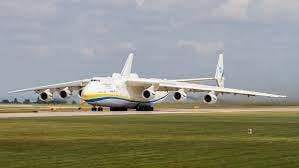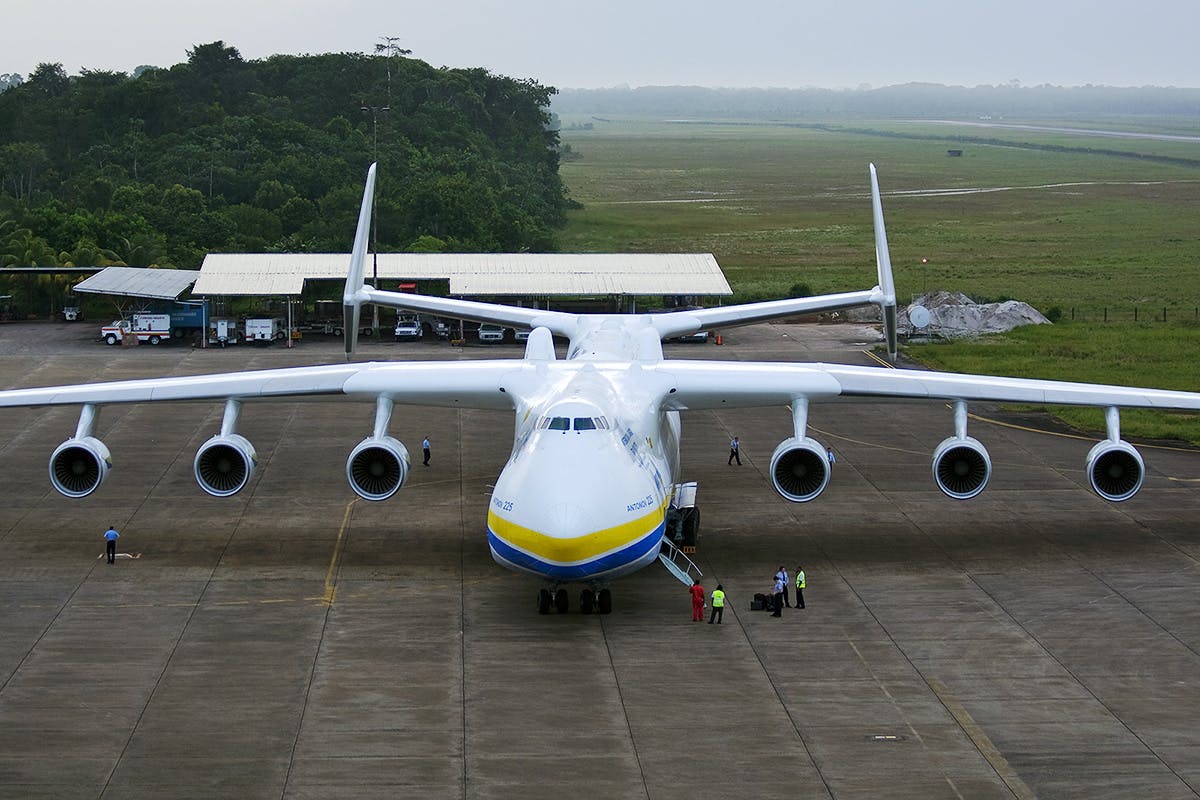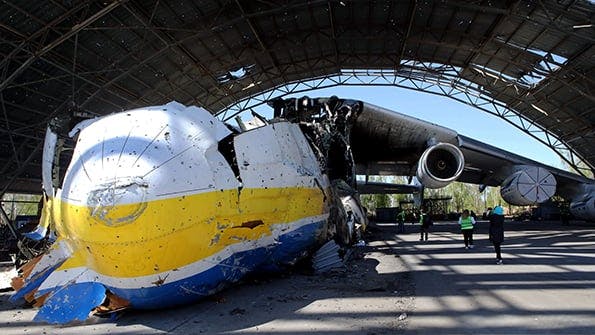Antonov An-225: The world’s largest, heaviest cargo aircraft (or it was)

Blog
In the good ol’ US of frickin’ A we take pride in super-sizing just about everything. From cheeseburgers, to breast implants (nope, not going to link to that one), to deficit spending, to balls of twine, bigger is simply better to many Americans. But despite creating such gigantic aerial icons as the Boeing 747 and the C-5 Galaxy, the USA doesn’t have a monopoly on gigantic airplanes… far from it.
This is the tragic story of the Ukrainian-built Antonov An-225 Mriya (meaning “dream” in Ukrainian), which held several records as the largest and heaviest cargo airplane in operation, until it was destroyed by the Russians in 2022.

The An-225 resulted from the USSR’s space program
In 1984, the Soviet government requested a large airlifter to support its space program, mainly for transporting the Buran spacecraft (essentially the Russians’ answer to NASA’s Space Shuttle and the 747-based Shuttle Carrier Aircraft that transported it to launch locations). Lead designer Viktor Tolmachev started with the existing Antonov An-124 Ruslan, and added stretched sections of the fuselage fore and aft of the wing to increase cargo space.
Most notably, the An-124’s 4-engine wings were lengthened enough to add 2 additional Progress D-18T turbofan engines (51,500 lb/ft of thrust per engine) for a total of 6. Since the intent was to carry the Buran space-plane on the back of the fuselage, the tail section had to be redesigned due to the buffeting or “dirty air” caused by the cargo. So the An-124’s conventional single-horizontal-stabilizer design was changed to a split-tail, twin stabilizer tailsection for the An-225.
The first (and only) An-225 made its maiden flight on December 21, 1988, and of course the collapse of the Soviet Union followed only a couple of years later. A second An-225 was partially built during the late 1980s for the Soviet space program, but it never reached completion. Over the intervening decades, interest in the Russian space program grew and waned, and the Russian federation toyed with the idea of completing the second Mriya, which was ostensibly going to be capable of carrying a capacity of 250 tons and would cost at least $300 million. However, the construction of the second An-225 hasn’t yet come to pass, and with the current situation with Russia and Ukraine, it seems unlikely to occur within the foreseeable future.
With its space-program missions on hold during the tumultuous birth of the Russian Federation, the first An-225 lay dormant and was even cannibalized for parts, but with capitalism seemingly flourishing in the former USSR, the country saw the utility of this super-large cargo lifter and the airplane was refitted and certified for commercial use in 2002. It received additional upgrades in 2009.

Was the Antonov An-225 actually the largest plane ever flown?
Well, yes and no. In terms of external dimensions, the Hughes H-4 Hercules (Spruce Goose) was 218 feet 8 inches (66.65 meters) long, 79 feet 4 inches (24.18 meters) high, with a wingspan of 320 feet and 11 inches (97.82 meters). The An-225’s wingspan was 290 feet (88.39 meters), so the Hercules had a wider wing. And the Hercules’ nearly 80-foot height also dwarfed the An-225’s 59.75-foot stature. However, the Spruce Goose’s length paled in comparison to the Antonov’s 275.4-foot overall length.
The Stratolaunch Roc, a truly massive, twin-fuselage, 6-engined aircraft designed as a flying launch platform for hypersonic vehicles or even orbital space missions, has a wingspan of 385 feet, a height of 50 feet, and a length of 238 feet. It can carry payloads of up to 500,000-550,000 pounds (226,000-250,000 kg), depending on which source you trust. But the Antonov was longer.
Where the Antonov excelled was in maximum takeoff weight and cargo capacity. The Antonov An-225 was the heaviest aircraft ever built, weighing an almost mind-boggling 285,000 kg (628,317.4 pounds). The famous Spruce Goose weighed “only” 300,000 pounds (136,077 kg) empty and was designed to carry 150,000 pounds (68,038 kg) of cargo.
How much cargo weight could the An-225 carry?
By far the most massive single-fuselage, “conventional” aircraft ever built, the Antonov 225 was truly a monster. It could carry ultra-heavy and oversized freight weighing up to 250,000 kg (550,000 lbs) internally or 200,000 kg (440,000 lbs) on its upper fuselage. Cargo on the upper fuselage could measure up to 70 meters (230 ft) long. Maximum takeoff weight was nearly 700 tons, or between 1,280,000 and 1,322,750 lbs, depending on the source you read.
For reference, the Lockheed C-5M Galaxy has an empty weight of 374,000 pounds (232,693 kg), is 247.8 feet (75.53 m) long, 65 feet (18.84 m) high, and has a wingspan of 222 feet (67.9 m). The current C-5M has a maximum takeoff weight of 840,000 pounds (381,000 kg).
The Galaxy has a massive cargo hold 121 feet (36.8 m) long, 19 feet (5.8 m) wide, and 13.5 feet (4.1 m) tall, and a carrying capacity of 285,000 lbs (129,274 kg). But the Antonov 225 Mriya’s cargo hold was a full 20 feet longer, at 141 feet long, 21 feet wide, and 14.3 feet tall, for a volumetric capacity of 1,100 cubic meters. The Antonov’s maximum cargo weight of 550,000 pounds was almost DOUBLE that of the C-5. It’s difficult to even comprehend that much weight being airborne.
In some of its flights, the An-225 transported complete 109-ton diesel locomotive engines, massive electric generators, 232 tons of oil and gas equipment, and, for its final cargo, 90 tons of Covid-19 testing equipment. During its lifetime the An-225 broke 240 world records, including the record for an airlifted single-item payload of 189,980 kg (418,834.2 pounds), which was a power plant generator, the record for an airlifted total payload of 253,820 kg (559,577.314 pounds), and the record for the longest payload (137-foot-long wind turbine blades).

From “dream” to nightmare
In February 2022, the single operational Antonov An-225 Mriya was parked in a massive hangar at Antonov Airport in Ukraine, having undergone a recent engine swap. NATO advised Ukraine that the plane should be prepared for evacuation under threat of Russian invasion, but on February 24, Russian forces attacked the airport, damaging the runway and preventing the aircraft from being moved. By February 27, Twitter photos had been posted of the An-225 on fire. The aircraft was completely destroyed (along with several other airplanes nearby). The dream was over.
According to PilotInstitute, “The Ukrainian state-owned manufacturer of the Antonov announced that the aircraft will be rebuilt at a cost of $500 million, which they aim to recover from Russia.” Yeah, good luck with that. We hope the Mriya will fly again, but from where we sit, Russia and Ukraine have quite a few other issues to work through first.
–By Jeff Davis, Intergalactic Scribe
Sources:
https://chapmanfreeborn.aero/news-and-blog/worlds-largest-cargo-aircraft/
https://simpleflying.com/antonov-an-225-wreckage-latest-photos/
https://supplychainbeyond.com/the-plane-that-eats-trains/